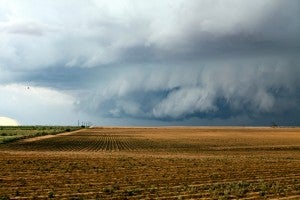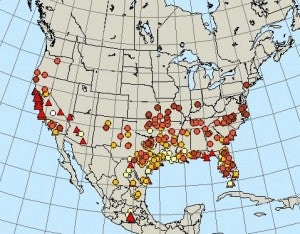
Rain builds over a field near Lubbock, Texas. Photo credit: Flickr user Craig O’Neal
I am watching the rain pour down outside my window as I write this blog. El Niño is once again giving central and north Texas a good drenching, which has brought with it some severe and deadly flood conditions. But the rains are a welcome sight to Texas farmers and ranchers who have become all too used to drought and wildfire conditions. And they aren’t the only ones benefitting from the heavy rains.
All this wet weather has resulted in a spectacular display of spring wildflowers, including vast expanses of milkweed and nectar plants that the iconic North American monarch butterflies need to survive and thrive.
Recent headlines suggest that milkweed loss is just one of several threats to monarch populations, with drought, habitat fragmentation and reduced availability of nectar plants also influencing the species’ decline. In reality, all of these threats are interconnected in a recipe that could spell disaster for the monarch.
Changing the trajectory
Whether it’s drought, herbicides or fragmentation that’s causing the loss of vital monarch habitat, it’s clear that the only way we can change the trajectory for the monarch is to ensure that larger swaths of habitat and important nectar sources are protected. So how do we do this?

The Journey North website shows that the eastern population of monarchs is currently making its way northward through Texas and Oklahoma. Photo credit: Journey North
There are a number of coordinated efforts in the works by conservation groups, state and federal agencies, and regular citizens to build a Monarch Highway – a 1,500 mile stretch of habitat from Texas to Minnesota that would connect key habitat corridors to allow the monarchs a safe migration north for the summer and south to Mexico for the winter.
But do you know what lies in the middle of that 1,500 mile stretch? The Corn Belt – home to the most intense agricultural production in the country.
We can’t expect to build a Monarch Highway without engaging farmers, and that will be the focus of my work at EDF for the next several years.
Field testing on farms
To help guarantee the monarch’s recovery, EDF is developing a Monarch Butterfly Habitat Exchange, which is designed to inspire vast numbers of farmers and ranchers to restore breeding and nectaring habitats on their property – namely on field edges, buffer areas and marginal lands that are well suited to this purpose.
In order for this to make financial sense for producers, the Monarch Butterfly Habitat Exchange uses a habitat quantification tool to assign credit values to the restored habitat, which can then be sold to investors – private companies or other conservation buyers – giving landowners a new revenue stream.
I have been working with experts at Environmental Incentives and the University of Minnesota’s Monarch Lab for the past five months to develop this quantification tool, which is now ready for field testing.
First stop: Texas

Photo credit: Flickr user John Flannery
Our first stop will be at Shield Ranch in central Texas. This nearly 5,000-acre ranch, which is located in western Travis County (home of Austin, Texas), has an active cattle operation, but is also home to the endangered golden-cheeked warbler. We expect that the property’s current wildlife-friendly grazing practices will be highly conducive to generating conservation credits for the monarch butterfly.
Our team of expert scientists will be at Shield Ranch on May 10 for the first field test of the monarch habitat quantification tool, which will provide essential insights on how the tool can be applied efficiently and effectively to grow monarch habitat.
We will continue gaining insights from other pilot testing along the monarch’s northern migration throughout the spring and summer – working with farmers and ranchers throughout the Corn Belt to gain even greater understanding of how the tool could support the launch of the Monarch Habitat Exchange next year. At that point, we hope to see hundreds of farmers and ranchers enrolling in the program and contributing to the monarch solution.
Related:
With help from farmers, the monarch butterfly will not go extinct >>
Butterfly numbers may be up, but they still need our help >>
Program helps Texas ranchers save endangered bird, but more conservation is needed >>










2 Comments
Great article! The photo shown is actually a Queen butterfly, not a Monarch. They are closely related, but not the same. You can tell a Queen from a Monarch because Queens have the white spots in the orange areas of their wings, Monarchs do not.
Thank you! Our communications team will correct it and be sure not to mix the two up in the future. Much appreciated!